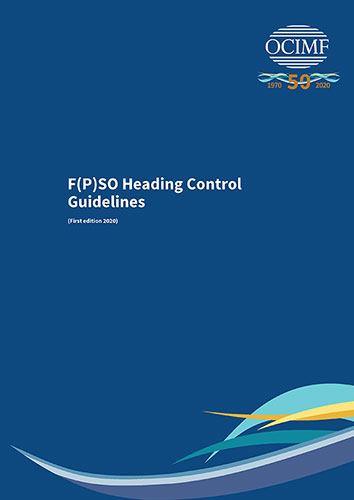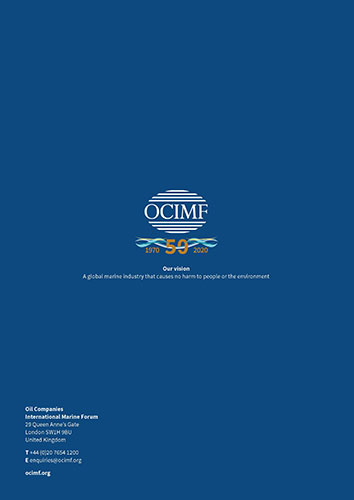F(P)SO Heading Control Guidelines/–Я–ї–∞–≤—Г—З–∞—П —Г—Б—В–∞–љ–Њ–≤–Ї–∞ –і–ї—П –і–Њ–±—Л—З–Є, —Е—А–∞–љ–µ–љ–Є—П –Є –Њ—В–≥—А—Г–Ј–Ї–Є –љ–µ—Д—В–Є. –†—Г–Ї–Њ–≤–Њ–і—Б—В–≤–Њ –њ–Њ –Ї–Њ–љ—В—А–Њ–ї—О –Ї—Г—А—Б–∞
–Ъ–љ–Є–≥–∞ –љ–∞ –∞–љ–≥–ї–Є–є—Б–Ї–Њ–Љ —П–Ј—Л–Ї–µ.
This information paper supplements the Oil Companies International Marine Forum's (OCIMF) publication Cargo Guidelines for F(P)SOs and should be read along with the relevant guidance for F(P)SO heading control.
These guidelines provide recommendations to safely manage heading control operations of turret moored Floating (Production) Storage and Offloading (F(P)SO) facilities. F(P)SO heading control operations are undertaken to enable surveys, installation works, maintenance works and associated F(P)SO operations, on board or within the swing circle, often while remaining in operation.
The bollard pull that is required to maintain a defined heading is often underestimated. An underestimated bollard pull may lead to an unwanted loss of position of the F(P)SO, subsequently endangering operations that require the heading control. Additionally, insufficient consideration has been given to the operational limits at which operations should be suspended or aborted.
Contents
Purpose and scope
Glossary
Abbreviations
Bibliography
1 Heading control operations
1.1 Risk of loss of F(P)SO heading control
2 Heading control assurance
2.1 Consequences of loss of F(P)SO heading control
2.2 Non-redundant F(P)SO heading control
2.3 Redundant F(P)SO heading control
2.4 Risk-based approach
2.5 Heading Control Tugs heading control management and records
3 Heading control: Assurance Category Identification (ACID) tool
3.1 Heading control assurance framework
3.1.1 Heading control assurance framework: Category A (low risk)
3.1.2 Heading control assurance framework: Category B (medium risk)
3.1.3 Heading control assurance framework: Category C (high risk)
4 Hazards
4.1 Metocean conditions
4.2 Heading control equipment failure
4.2.1 Heading Control Tug power failures
4.2.2 F(P)SO thruster failures
4.2.3 Combined F(P)SO thruster and Heading Control Tug operation
4.2.4 Heading control using multiple Heading Control Tugs
4.2.5 Towline assembly failure
4.3 Subsea hazard
4.3.1 Water depth
4.3.2 Consequences of failure to manage the towline catenary
4.3.3 Calculation of catenary
4.3.4 Underwater field layout
4.4 Loss of communications
4.5 Human factors
4.6 Simultaneous Operations and Heading Control Tugs
4.6.1 Diving
4.6.2 Remote Operated Vehicle operations
4.6.3 Turret works
4.6.4 Cross rigging with chains, ropes and hoses
4.6.5 Supply vessel operations
4.6.6 Personnel transfer
4.6.7 Helicopter operations
4.6.8 Offtake tanker operations
4.6.9 Gas venting requirements
4.6.10 Interference with Lifesaving Appliances equipment
4.7 Emergency preparedness
4.7.1 F(P)SO Activity Specific Operating Guidelines
5 F(P)SO heading control system redundancy
5.1 F(P)SO design and operations
5.1.1 F(P)SO design
5.1.2 F(P)SO redundancy
5.2 Heading Control Tug design and operations
5.2.1 Heading Control Tug design
5.2.2 Heading Control Tug operations
5.3 Redundancy for F(P)SO thrusters and Heading Control Tugs combined
6 Crew training and competency
6.1 Awareness of mooring equipment
6.2 Connection/Disconnection procedure
6.3 Use of Tow Master
6.4 Reporting line for heading control operations
6.5 Roles, accountability and responsibilities
7 Requirements for F(P)SO deck equipment
7.1 Service life requirements
7.2 Deck layout and line-up of equipment
7.3 Winches and capstans
7.4 Chocks and fairleads
7.5 Towing strong point
7.5.1 Heading Control Tug emergency release from F(P)SO
7.6 Messenger lines
8 Heading Control Tug suitability
8.1 Capabilities
8.2 Heading Control Tug selection for suitability
8.2.1 Alignment with Static Towing Assembly Guidelines
8.2.2 Emergency response and contingency procedures
8.3 Heading control operations
8.4 Heading control trials
9 Communication procedures
9.1 Internal communications
9.2 External communications
9.3 Redundant/Emergency communications
9.4 Pre-operations meetings
9.5 Communication protocol
9.6 Information reporting requirements




